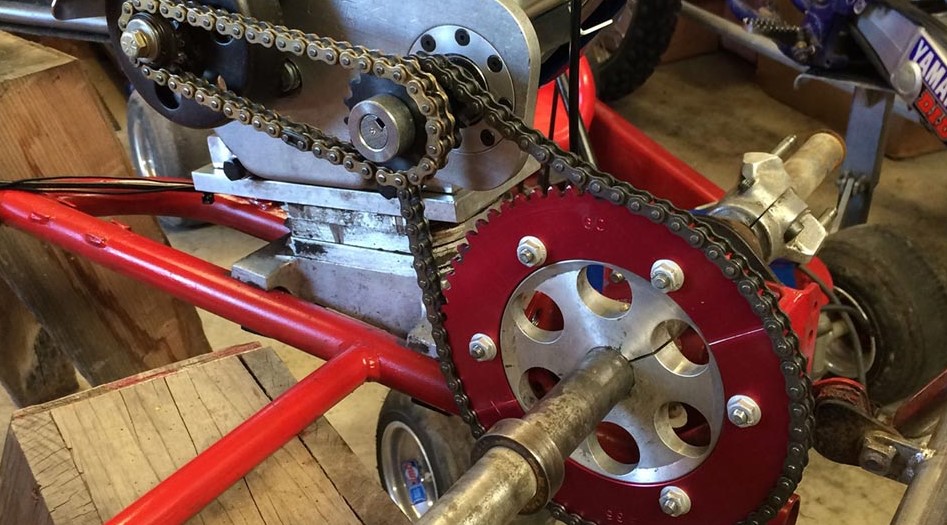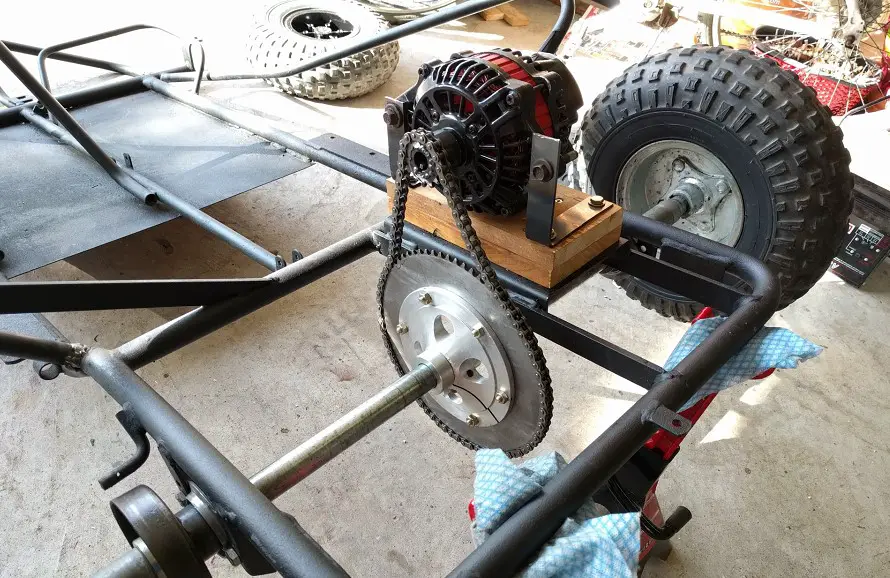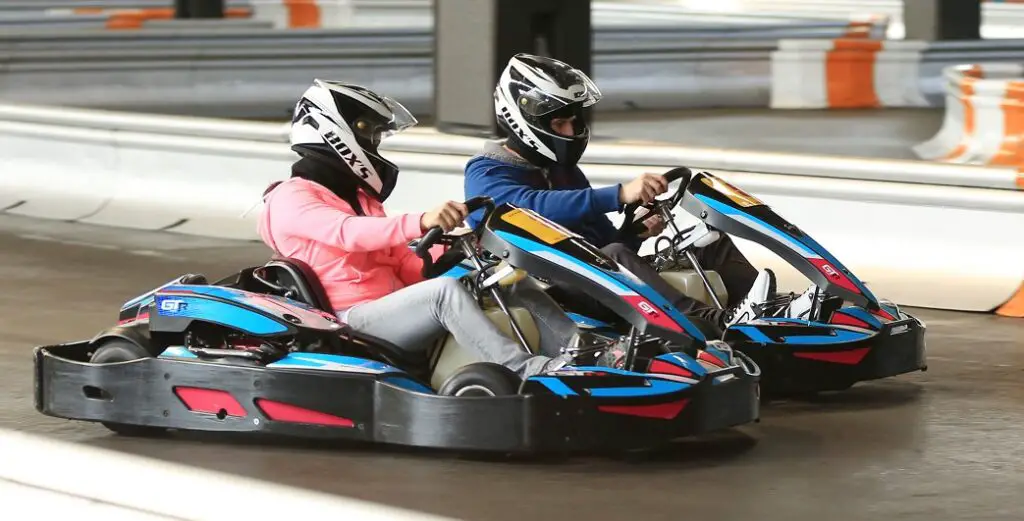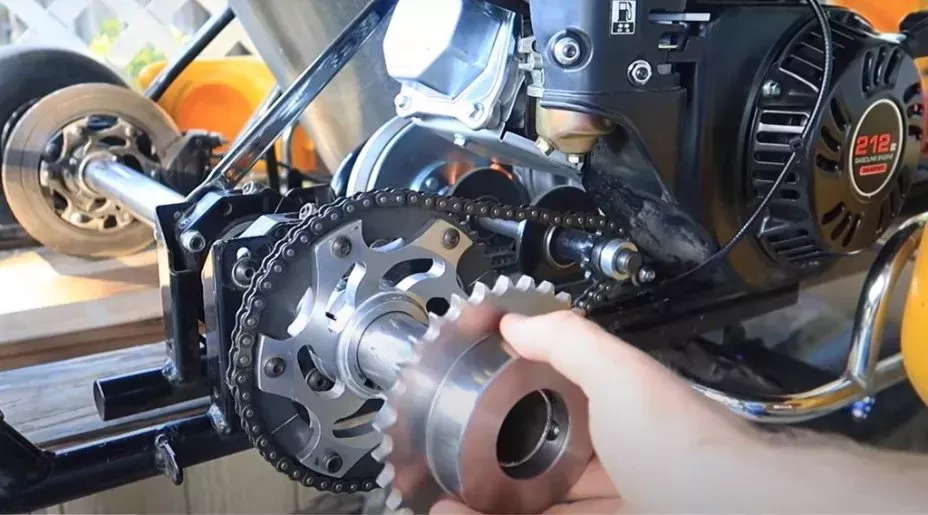The best gear ratio is one of the most meaningful things in a go-kart. In track races, the perfect transmission ensures the most efficient use. This rate affects acceleration and top speed, which is important on straight roads and tight curves.
However, it’s not always simple to find the best definition, so you’ll need some tools. You can find advice and directions to assist you in determining the best gear ratios in this article.

Go-kart gear ratio definition and meaning
Probably the best way to customize karts to your liking is to remake them. Let’s understand what is the gear ratio of karting and why is it so important.
The gear ratios are the ratio of the number of teeth on two gears that are in mesh. This rate is expressed mathematically. In other words, if your kart is in fourth gear, the clutch sprocket must turn four times before the rear axle sprocket can turn once.
For example, the go-kart has a 12-tooth clutch and a 54-tooth clutch sprocket on the rear axle pinion. To find the rate, simply divide 54 by 12, which in this case is 4.50:1.
Now let’s see why it is so important to know the gear ratios of a go-kart.
If the rate is incorrectly set from the start, the clutch can eventually destroy it. Knowing how to configure gear ratios properly gives you a competitive edge.
The majority of go-kart racers believe that high gear ratios are necessary for a racing go-kart.

Working principle of go-kart gear ratios
Each go-kart has gears. The manual transmission in the go-kart forces the driver to change gears on their own, while the automatic transmission does this at the expense of the engine.
The engine may overheat, especially in hot weather or when the engine is not cool enough. To prevent the engine from overheating and exploding, the automatic transmission keeps the engine rpm within a certain range. That’s why you need to be an experienced racer to operate derailleur karts in order not to blow the engine in every race as they are not cheap.
Because all powertrains in racing go-karts have to keep the engine’s rpm within the permissible range, they are often quite simple. A go-kart with an automatic transmission does not shift while driving. However, if you listen closely to the running engine, the rate when changing gears decreases.
However, when it comes to professional racing, the go-kart racing distraction is the biggest problem. However, there are numerous configurations for single-speed go-karts and gearshifts that can be used to accelerate more quickly. Changing the gear ratios is a crucial tactic for achieving better results.

Gear ratio basics
If you have a shaft (e.g. the drive shaft of an engine) whose power you want to transfer to another shaft (the rear axle sprocket on which the wheels are mounted), two sprockets must usually be used become and a chain.
The size of the first gear relative to the size of the second gear is the gear ratio.
It is usually expressed as a fraction of the number of revolutions of the small gear required to complete one revolution of the large gear.
The more revolutions the driving axle sprocket requires for one revolution of the rear sprocket, the “shorter” the gear ratios. Conversely, the lower the engine sprocket revolutions required for one revolution of the rear-driven sprocket, the higher the gear ratio is considered.
For example, if you have a 100mm pinion on the output shaft and a 100mm pinion on the output shaft (rear axle), you will get a gear ratio of 1 revolution to 1: 1. This would be a ratio of, which is considered “high”.

What will lead to the wrong choice of go-kart gear ratios?
It’s easy to get it wrong. But at the same time, most of the people on the trail around you have the best gear ratio. So setting up your go-kart gear ratios wrong can spell disaster and you could lose your rhythm.
The best go-kart gear ratios won’t necessarily give you the best lap times in the world, but they will help you keep up with everyone else. Getting the best gear in go-karts is much more difficult and can give you an advantage on race day if you overtake at the end of a straight.
Incorrect translation into go-karts can result in a loss of speed in qualifying if the go-karts cannot accelerate out of corners fast enough. Many drivers can overtake you on race day if your gear ratio is not high enough to reach top speed.

How to find the right rate for your kart
You can determine the top rate by knowing the go-karts gear ratio, rpm, and tire height.
What we need:
- clutch/engine sprocket teeth
- rear axle gear
- tire height (diameter)
- maximum engine speed
You can also use the reverse gear calculator to find the best gear ratio. This means you can determine the right rate by looking at the speed you want to use and adjusting the rate sliders.
When you change the rate, you also need to consider additional stressors. A higher top speed correlates with a lower gear ratio.

How to use the gear ratio and speed calculator?
The calculator requires four inputs or choices to calculate the top speed and gear ratio.
Required values for go-karts:
Engine RPM – Maximum engine RPM (e.g. select 3500 if the range is 2800-3500).
This value is listed in the owner’s manual.
Engine Sprocket (Teeth): Number of teeth on the engine sprocket. Use the clutch pinion tooth count instead if you are using one.
Teeth count: The pinion teeth attached to the rear sprocket are called the axle rack (teeth).
Take the first number, e.g. 11 x 6.00 – 5 to calculate tire height (diameter) – tire height.
Additional values for go-karts:
The number of teeth on your countershaft input sprocket is an optional setting.
The number of teeth on your countershaft output sprocket is an optional setting.

How does the gear ratio affect the rate and torque?
This is the gear ratio between the angular velocities of the motor and the axle/wheel as defined by the gear ratio. The wheel rotates at 3600/5 = 72 rpm when the crankshaft rotates at 3600 rpm and the ratio is 5:1.
To increase the ratio and top speed, a smaller chainring is to be installed. Assuming a higher gear ratio on your engine can still produce the same RPM.
Then again, why not simply turn the go-kart gear ratio to 1:10 to generate 36,000 revolutions per minute on the axle?
The same amount of fuel burned determines the power generated by the engine. The crankshaft of the engine transmits the power to the wheel.
Therefore, you pay the price when you change the go-kart gear ratio and increase the rate of the axle. You don’t have enough torque to start the go-kart if the desired gear ratio is too low.
And even if you can start, the go-kart high gear ratio will damage the torque converter or burn out the clutch.
The clutch sprocket will slip in the go-kart gear ratio, causing more heat and possible breakdowns.
It’s also important to think about what you want most: better acceleration at the start. Fastest top speed? Go-kart acceleration increases when the rate is changed to increase torque sprocket, but top speed decreases.

Factors that can affect the kart gear ratio
A kart’s gear ratio depends on many factors. It’s important to have an engine sprocket on hand in case you have to take this into account and need to replace them quickly.

Various tracks and layouts
The first and most obvious factor affecting gear ratio is changing the position of the chain. This can be anything from different layouts to minor layout changes like adding corners or straight lines.
Driving styles
The second is a go-kart ride. Some drivers have a very relaxed driving style. This allows the engine to run at higher revs and achieve a higher top speed. Others have a more aggressive and direct driving style that requires faster acceleration. Find your riding style and use the right gear.
Weather
The final factor to consider is the weather. The main problem is rain. Rain reduces top speed, so you have to shift into a higher gear to allow the engine to reach the rev limiter at the end of the straight. However, with this big gear, you get faster acceleration and more wheel spin. So we have to find the balance again.

Shifter karts or single-speed?
A dilemma faced by both karting beginners and those who have experience and want to try something new. In addition to the choice between hard and soft tires, kart drivers must also decide whether to buy go-karts with or without kart equipment.
It has been found that those who race KZ (shifter kart) at the amateur level often (but not always) started racing karts at a later age or with little experience with single-speed karts (some even started straight away with KZ).
Go-kart gears are well known to be both physically and financially taxing. Since it can only be “held” with physical training, it must be operated with one hand for half of each lap. This results in a driving style that is very different from single-speed driving and makes shifter karts more like go-karts (remember, go-karts also have front brakes).
One benefit of a go-kart gearshift is that you can always downshift if you make a turning error.
There is less chance of error correction with a single speed tag. To learn the fundamentals of go-kart driving, such as racing go-karts and corners, the majority of drivers always advise beginning with a single-speed kart.
Shifter karts are said to be a great challenge for “beginners,” who are drawn to adrenaline-fueled emotions and strong feelings. They are faster and more powerful.

FAQs
The optimal gear ratio for a go-kart is 6.1.
To find the go-kart ratio, divide the rear axle pinion by the clutch pinion. 60 divided by 12.
Typically these go-karts produce 48 kW (65 hp) and are capable of 210 km/h (130 mph).
A larger rear sprocket and a smaller front sprocket (or motor sprocket) will improve acceleration but reduce top speed.
Axle sprockets, also called pinions, are toothed steel wheels. The cart has front and rear sprockets facing each other and connected by a chain. They are used to transmit rotary motion between the engine’s crankshaft and rear axle.
Conclusion
If you’re wondering why go-karts don’t have reverse, the answer is pretty simple. The kart just needs to go fast and win the race. Why put something in a kart that adds weight and just makes it roll backward? Of course, it is not necessary.
As a general rule, every track is unique, so you should always talk to other drivers to see what setup they are using. Always test a few gears to see which one works best for your riding style. Don’t forget to find the best gear ratio.